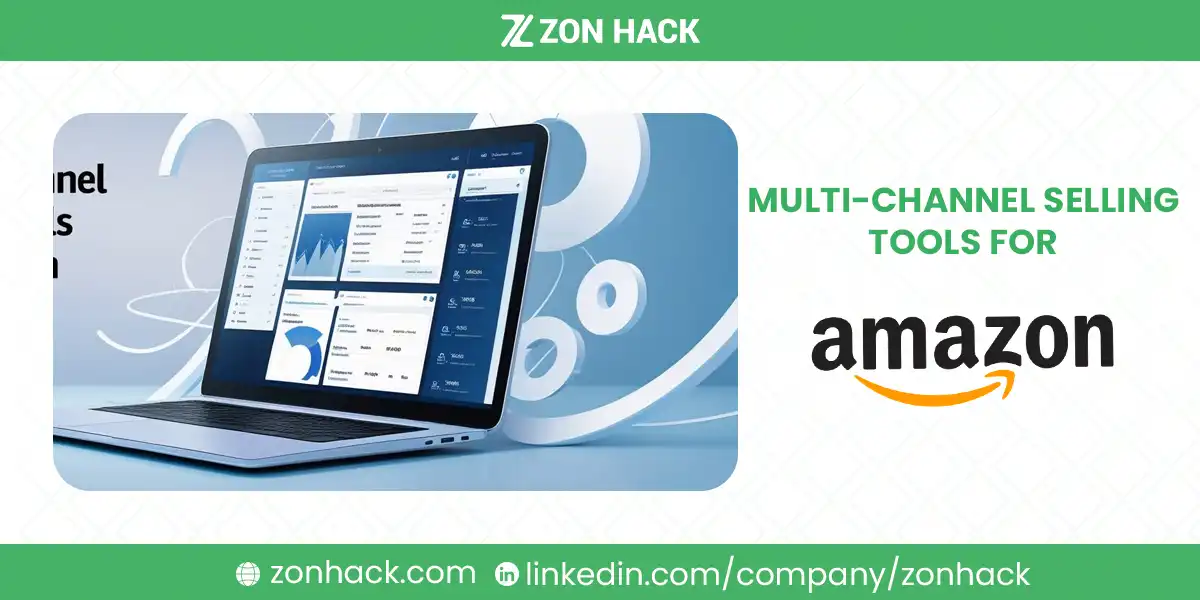Imagine a storefront that never sleeps — now multiply it across every platform your customers shop on.
That’s multi-channel selling.
Instead of relying solely on Amazon, sellers diversify by listing their products across platforms like eBay, Walmart, Shopify, Etsy, and even emerging options like TikTok Shop or Facebook Marketplace. It’s not just a tactic — it’s a strategic shield against platform dependence and shifting algorithms.
If you’re an Amazon seller, multi-channel selling means growth, stability, and the ability to meet your customers where they actually are — not just where you wish they were.
Why Multi-Channel Selling Is Essential for Amazon Sellers
Selling on Amazon is powerful. But it’s also risky when it’s your only channel.
According to Statista, 86% of online shoppers use two or more platforms before completing a purchase. That means your potential buyer might start on Amazon but finish on Walmart, TikTok, or your own website.
And that’s not just a trend — it’s a behavior.
Shoppers who use multiple platforms don’t just buy more often. They spend 30% more over their lifetime, according to data from Omnisend. That’s not just more sales — it’s better sales.
When you show up on more channels, you don’t just chase revenue — you future-proof it.
You also gain a competitive edge.
Sellers relying solely on Amazon are vulnerable to sudden policy changes, algorithm shifts, or account suspensions. Sellers who spread their footprint are more agile and less affected by disruptions.
But with this opportunity comes complexity.
The Operational Challenge of Going Multi-Channel
Growth isn’t free. It brings complications.
When you list the same product on five different marketplaces, you’re not just managing listings — you’re juggling inventory, pricing, fulfillment, returns, and customer messages across all of them.
And it’s easy to drop the ball.
Inventory sync issues can lead to overselling. Delays in fulfillment can cause negative reviews. Conflicting branding across platforms can damage trust. All of this drains revenue and reputation.
The common symptoms of poor multi-channel management?
- Missed orders
- Canceled shipments
- Duplicate support requests
- Wrong product listings
- Inconsistent pricing
It becomes unmanageable — unless you have the right systems in place.
Why Tools Are Non-Negotiable
Without automation, multi-channel selling becomes a full-time firefight.
The right tools don’t just save time — they make scale possible. Instead of manually updating spreadsheets or logging into five seller portals every day, sellers use software to:
- Sync inventory across channels
- Centralize product listings
- Automate order routing
- Consolidate customer communications
- Track performance in real time
That’s not a luxury — it’s a necessity.
If you’re serious about building a resilient, scalable business outside Amazon, multi-channel tools are your infrastructure.
Key Multi-Channel Selling Challenges (And the Tools That Solve Them)
Branding and Experience Consistency
Your brand’s reputation doesn’t stop at Amazon. A customer who buys from your Shopify store should get the same product images, descriptions, and polished experience they would expect anywhere else.
But consistency is tough when you’re updating five systems manually.
This is where tools like Listing Mirror or SellerActive come in. They sync your product listings, titles, variations, and media assets automatically across platforms.
This ensures your brand looks and performs the same, no matter where the sale happens.
Inventory Visibility and Overselling Prevention
Selling the same product across Amazon, Walmart, and eBay without proper syncing is a disaster waiting to happen.
If inventory isn’t updated in real-time, you risk overselling, backorders, or worse — order cancellations that hurt your seller performance metrics.
Amazon is particularly unforgiving.
To avoid this, sellers turn to platforms like Linnworks, Sellbrite, or SkuVault, which offer centralized inventory control. These tools update inventory levels in real-time the moment a product sells, no matter the platform.
That means one sale on Walmart immediately reflects on your Amazon, Shopify, and eBay listings — all automatically.
Fragmented Customer Engagement
When a customer messages you on eBay, follows up via Shopify chat, then leaves a comment on TikTok, it’s easy for things to fall through the cracks.
Missed messages = missed revenue.
That’s why many sellers integrate CRM systems like Freshworks, HubSpot, or Zoho CRM to capture every interaction in one place.
These tools allow sellers to:
- See a full customer history
- Automate post-purchase follow-ups
- Trigger review requests
- Track satisfaction across platforms
For Amazon-specific feedback tracking, FeedbackWhiz gives you the ability to monitor reviews, send automated follow-ups, and even segment outreach by order type or customer location.
Fulfillment Inefficiencies and Delays
Let’s say you get 100 orders a day — 30 from Amazon, 25 from your Shopify store, 15 from Walmart, 10 from TikTok, and the rest from eBay.
If you’re fulfilling each channel separately — using different shipping labels, providers, and packaging — your operations are bleeding money and time.
Amazon Multi-Channel Fulfillment (MCF) solves this.
With MCF, Amazon stores and ships all your inventory — including orders that come from other platforms. Orders are shipped in non-Amazon packaging, and customers get 2-day delivery, just like they would from Prime.
It eliminates the need for third-party warehouses or custom fulfillment setups.
Tools like ShipStation, Pipe17, and Order Desk integrate directly with MCF to automate order routing, making fulfillment truly hands-off.
Categories of Essential Multi-Channel Selling Tools
Let’s dive deeper into the essential tools that make this whole ecosystem run.
Amazon Multi-Channel Fulfillment (MCF)
MCF is Amazon’s behind-the-scenes logistics engine for non-Amazon orders. Think of it as FBA, but for your entire online store.
How It Works:
- You send inventory to Amazon’s fulfillment centers
- Orders from other platforms (Shopify, eBay, etc.) trigger Amazon to pick, pack, and ship
- Orders arrive in plain packaging, not Amazon-branded boxes
- You can monitor everything from your dashboard or integration
Key Stats:
- 97%+ on-time delivery rate
- 2-day shipping available in most regions
- Real-time tracking for every order
Best Use Cases:
- Shopify stores offering Prime-style shipping
- TikTok Shop sellers needing fast, reliable fulfillment
- International brands expanding to U.S. markets without new warehouses
Limitations:
- No custom packaging (unlike ShipBob or Deliverr)
- Costs vary by item size/weight
- Inventory thresholds may limit usage during peak seasons
Still, for Amazon-native sellers looking to expand fast, MCF is a powerful launchpad.
CRM and Customer Feedback Management Tools
Multi-channel success isn’t just about fulfilling orders. It’s also about building relationships — and that starts with keeping your customer experience consistent and personalized across every channel.
When you’re selling on Amazon, Shopify, Walmart, and even TikTok Shop, customer conversations can easily become fragmented.
Someone might email you from your website, message you through eBay, or leave feedback on Amazon — and if you’re not managing all those touchpoints centrally, you’ll lose context fast.
This is where a Customer Relationship Management (CRM) system steps in.
A good CRM collects all customer data, interactions, and buying history in one place. It gives you a clear picture of who your buyers are, what they’ve purchased, and how they’ve interacted with your brand.
Recommended CRMs for Amazon-Centric Sellers
- HubSpot CRM – Ideal for small-to-medium businesses. The free version is robust, offering email automation, contact organization, and sales tracking.
- Zoho CRM – A budget-friendly option with strong multi-channel messaging features, great for sellers who want to manage both support and marketing in one place.
- Freshworks – Offers AI-powered contact scoring, email tracking, and integration with platforms like Shopify and WooCommerce.
- Pipedrive – Useful if your brand leans toward high-ticket or B2B sales, especially for managing deal flows.
Customer Feedback Tools
Specifically for Amazon, tools like FeedbackWhiz are designed to monitor reviews, automate post-purchase messaging, and alert you to negative feedback before it spirals.
Remember: Your customer experience is your brand. These tools ensure that no message is missed, no review goes unnoticed, and no buyer is left feeling ignored.
All-in-One Multi-Channel Management Platforms
If you’re overwhelmed juggling listing tools, CRMs, order managers, and inventory software, an all-in-one solution may be your best bet.
These platforms consolidate multiple functions — listing, inventory syncing, order routing, shipping, and analytics — into a single, centralized dashboard.
Think of them as your command center.
Top Solutions to Consider
- SellerActive – Known for its real-time repricing engine, inventory sync, and deep integration with Amazon’s MCF. A strong pick for sellers managing multiple high-volume SKUs.
- Brightpearl – More than just an MCM tool, it combines enterprise resource planning (ERP) with order and inventory management, great for larger businesses needing advanced reporting and forecasting.
- Expandly – Designed for multi-platform listing across Amazon, Etsy, Walmart, and your own store. Offers clean UI and beginner-friendly setup.
- Extensiv (formerly Skubana) – Built for serious eCommerce operations. Strong in warehouse logistics and multi-location inventory management.
With these tools, you reduce friction between teams and platforms, ensuring that your operations scale as quickly as your revenue does.
Integrations and Automation Workflows
The real magic of multi-channel selling lies not in managing more — but in automating more.
The best tools don’t just function well. They also talk to each other seamlessly.
From syncing orders to tracking shipments and automating inventory updates, integrations ensure that your tech stack works as a connected ecosystem, not a collection of silos.
Types of Integrations
- Built-In Amazon Integrations – Shopify, BigCommerce, and WooCommerce offer native apps for Amazon FBA and MCF. These plug-and-play tools eliminate the need for manual connections.
- Third-Party Middleware – Tools like Pipe17, Order Desk, or WebBee serve as bridges between your marketplaces and back-end systems. Think of them as flexible plumbing that connects otherwise incompatible platforms.
- Custom APIs – For larger or highly specialized businesses, custom-built API integrations ensure total control over workflows, especially when using proprietary storefronts or unique inventory setups.
Why This Matters
Without reliable integrations:
- Orders fall through the cracks
- Inventory updates lag behind
- Fulfillment errors increase
- Reporting becomes patchy and unreliable
But with the right tech stack in place, you can route orders in real time, sync inventory within seconds, and offer a consistent experience across channels — all without lifting a finger.
Choosing the Right Multi-Channel Tools for Your Business
Now that you know what’s out there, how do you decide what to use?
The truth is, there’s no single “best” tool. The right stack depends on your product mix, volume, channels, and customers. But here’s how to break it down:
A. Start with Your Customer
Ask yourself:
- Where do your customers shop?
- Are they more active on Amazon or DTC channels like your Shopify store?
- Are they influenced by TikTok trends, Etsy aesthetics, or big-box credibility from Walmart?
Knowing this will guide which platforms you prioritize — and therefore which integrations and tools you need first.
B. Match Tools to Your Business Model
Different sellers need different setups.
- If you’re a DTC brand, prioritize tools that offer brand control and customer engagement (e.g., Shopify + HubSpot + MCF).
- For wholesalers or B2B-focused sellers, CRMs like Zoho or Salesforce will provide better sales pipeline visibility.
- If you rely on Amazon FBA, choose tools that integrate deeply with Amazon rather than fighting it.
C. Analyze Total Costs and ROI
Don’t get caught chasing cheap tools that don’t scale. At the same time, avoid bloated enterprise platforms if you’re still growing.
Consider:
- Monthly or annual software fees
- Integration or onboarding costs
- Fulfillment and storage expenses (especially with MCF or 3PLs)
- Customer support availability and quality
- Exit and switching costs
Use real data from your business to project ROI — and make decisions that support long-term growth, not just short-term savings.
D. Define Your Integration Stack
Your tools should form a tech ecosystem — not a patchwork.
Before committing:
- Ensure your listing tool talks to your inventory system
- Make sure your CRM can pull customer data from all platforms
- Double-check that order routing flows logically to fulfillment centers
If you’re still copy-pasting SKUs or manually adjusting stock levels, your stack isn’t working for you — you’re working for it.
E. Trial, Test, and Optimize
Most top tools offer free trials, demos, or sandbox environments.
Use them.
Run real orders. Check for fulfillment speed. Measure customer service response time. Stress-test integrations. Get feedback from your team.
Then refine. Add tools, remove tools, or upgrade plans based on actual performance.
Don’t aim for perfection — aim for progress.
Bottom Line: Smart Tools = Scalable Selling
Amazon might be the starting point — but it shouldn’t be the endpoint.
Multi-channel selling is how modern eCommerce brands grow with resilience. It diversifies risk, multiplies reach, and increases customer loyalty.
But without the right tools, this growth turns into operational chaos.
Tools like Amazon MCF, SellerActive, Linnworks, and HubSpot don’t just automate your workload — they give you the visibility, speed, and flexibility to scale.
At ZonHack, we work closely with Amazon and DTC brands to help them scale smart — with the right systems, the right data, and the right tools in place.
Start simple. Scale fast. And let your multi-channel strategy do the heavy lifting.
FAQs
What is the best tool for syncing inventory across Amazon, Shopify, and Walmart?
Tools like Linnworks, Sellbrite, and Listing Mirror are designed for real-time inventory syncing across multiple platforms.
Can I use Amazon FBA to fulfill orders from other platforms?
Yes. With Amazon Multi-Channel Fulfillment (MCF), you can fulfill orders from your own site, eBay, or Walmart using Amazon’s warehouse network.
Is multi-channel selling worth the cost of added tools?
Yes — as long as you’re choosing tools that match your scale and goals. The increase in reach, revenue, and customer retention often justifies the cost.
How do I avoid branding inconsistencies across platforms?
Use listing tools that allow centralized control of images, descriptions, and pricing, such as SellerActive or Veeqo.
Do I need a CRM if I only sell on Amazon?
You don’t need one, but if you’re collecting email addresses, running ads, or want to build a brand, a lightweight CRM like HubSpot or Zoho can make a big difference.




